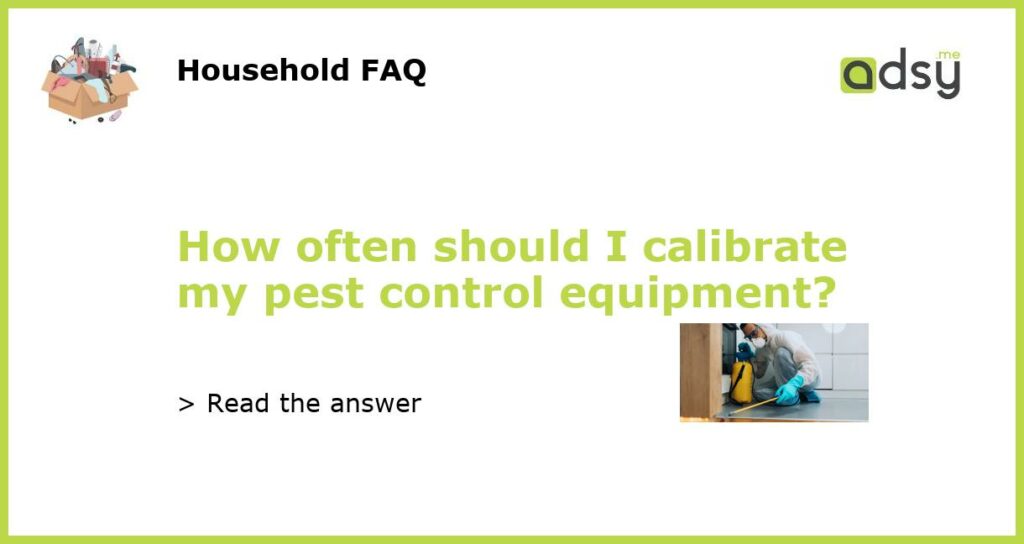How often should I calibrate my pest control equipment?
Calibrating pest control equipment is an essential part of maintaining effective pest management practices. It ensures that the equipment is providing accurate and precise application of pesticides, which is crucial for controlling pests efficiently and reducing the risk of under or overapplication. The frequency of calibration depends on several factors, including the type of equipment, the pesticides used, and the specific regulatory requirements in your area.
Types of pest control equipment
There are different types of pest control equipment, including backpack sprayers, handheld sprayers, foggers, and bait stations. Each type of equipment requires different calibration methods and intervals. It is important to consult the manufacturer’s instructions for guidelines on calibration.
Factors affecting calibration frequency
Several factors need to be considered when determining how often you should calibrate your pest control equipment:
- Pesticide type: Different pesticides have different formulation properties, such as viscosity and density, which can affect the flow and dispersal of the product. Some pesticides may require more frequent calibration to ensure accurate application.
- Application volume: The volume of pesticide applied per unit area can vary depending on the target pest, the size of the area being treated, and the desired level of control. If you are applying higher volumes, more frequent calibration may be necessary to maintain consistency.
- Environmental conditions: Environmental conditions, such as temperature and humidity, can impact the performance and effectiveness of pesticides. It is important to consider these factors when calibrating equipment, as changes in environmental conditions may require adjustments to the calibration settings.
- Regulatory requirements: Some regulatory agencies may have specific guidelines or requirements regarding calibration intervals for pest control equipment. It is important to stay informed about any regulations or guidelines that apply to your area.
- Equipment maintenance: Regular maintenance of your pest control equipment can help ensure its accuracy and performance. This includes cleaning and inspecting the equipment, replacing worn or damaged parts, and lubricating moving parts. Regular maintenance can also help identify any calibration issues that may need to be addressed.
Recommended calibration intervals
While the specific calibration interval will vary depending on the factors mentioned above, there are some general guidelines that can help you determine when to calibrate your pest control equipment. It is important to note that these are general recommendations and may need to be adjusted based on your specific circumstances:
- Regular calibration: It is recommended to calibrate your pest control equipment at the beginning of each season or whenever you start using a new pesticide. This helps ensure that the equipment is properly calibrated for the specific product being used.
- Periodic calibration: In addition to regular calibration, it is also recommended to periodically check the calibration of your equipment throughout the season. This can help identify any drift or changes in calibration that may occur over time.
- Event-based calibration: If you experience any issues with pesticide application, such as poor pest control or inconsistent coverage, it may be necessary to calibrate your equipment immediately to address the problem.
- Manufacturer recommendations: Always consult the manufacturer’s instructions and recommendations for specific calibration intervals for your equipment. They may have specific guidelines that are tailored to your equipment model and pesticide formulations.
Benefits of regular calibration
Regular calibration of pest control equipment offers several benefits:
- Optimal pest control: Accurate calibration ensures that the right amount of pesticide is applied to control pests effectively. Under or overapplication can lead to poor pest control and increased risks to human health and the environment.
- Cost savings: Properly calibrated equipment helps prevent overapplication of pesticides, reducing unnecessary waste and costs. It also ensures that the pesticides are effectively controlling pests, minimizing the need for additional treatments.
- Compliance with regulations: Calibrating your equipment according to regulatory requirements helps ensure compliance with applicable laws and regulations related to pesticide use.
- Reduced environmental impact: Accurate calibration helps minimize pesticide drift and runoff, reducing the potential impact on non-target organisms and water resources.
- Improved safety: Proper calibration reduces the risk of exposure to pesticides for both applicators and the general public. It helps ensure that pesticides are applied only where needed and in appropriate quantities.

